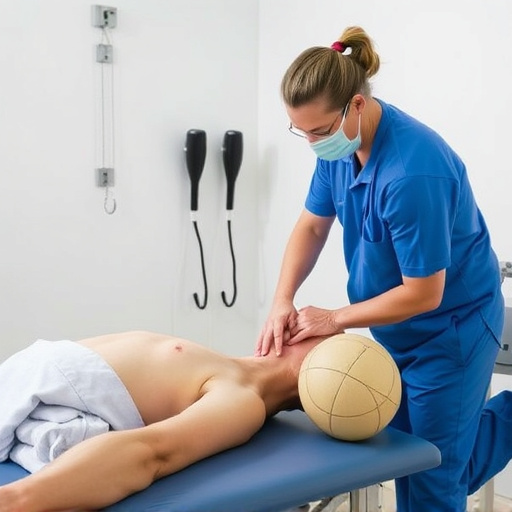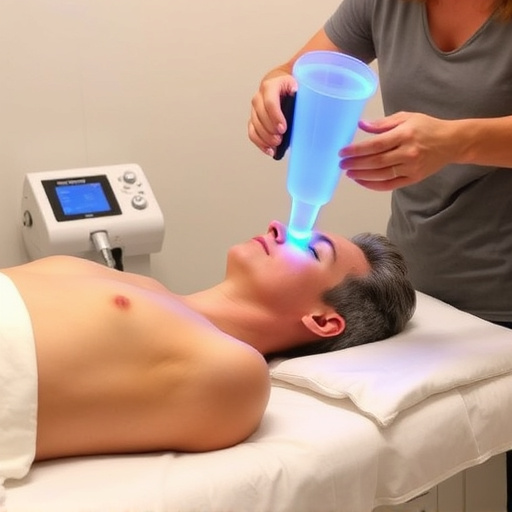Shockwave therapy, using low-energy sound waves, offers a non-invasive treatment for plantar fasciitis. It accelerates tissue regeneration in the fascia, reducing pain faster than traditional methods and providing an alternative to injections or surgery. The multi-stage healing process involves micro-trauma stimulation, inflammation clearance, fibroblast proliferation, and collagen remodeling, leading to improved tissue integrity and reduced associated pain. Clinical evidence strongly supports its effectiveness in promoting tissue regrowth, relieving heel pain, and decreasing reliance on medication, allowing individuals to regain mobility and perform normal activities.
“Discover how shockwave plantar fasciitis treatment revolutionizes tissue regeneration. This non-invasive therapy offers a promising solution for chronic heel pain sufferers. In this article, we explore its underlying mechanisms, delving into how focused shockwaves stimulate cellular repair and promote collagen production. We’ll also examine clinical studies showcasing its effectiveness in reducing pain and improving mobility. By understanding the science behind shockwave therapy, patients can make informed decisions about their plantar fasciitis management.”
- Understanding Shockwave Therapy for Plantar Fasciitis
- Mechanisms of Tissue Regrowth After Shockwave Treatment
- Clinical Evidence and Benefits of Shockwave Plantar Fasciitis
Understanding Shockwave Therapy for Plantar Fasciitis

Shockwave therapy for plantar fasciitis has gained popularity as a non-invasive treatment option for chronic heel pain. This innovative approach uses low-energy sound waves to stimulate tissue regeneration and promote healing in the affected area, specifically targeting the plantar fascia—a thick band of tissue connecting the heel bone to the toes. The process involves delivering shockwaves directly to the inflamed or damaged regions, which can be caused by various factors like repetitive strain, intense physical activity, or even car accident injury care.
Unlike traditional treatments such as rest, ice, and therapeutic exercises for plantar fasciitis, shockwave therapy offers a faster and more efficient path to recovery. It enhances blood flow to the injured tissue, encouraging functional rehabilitation and reducing pain. This method is particularly beneficial for individuals seeking an alternative solution to corticosteroid injections or surgery, providing a safe and effective route to alleviate symptoms and restore mobility.
Mechanisms of Tissue Regrowth After Shockwave Treatment

After undergoing shockwave plantar fasciitis treatment, the body initiates a series of complex mechanisms to promote tissue regrowth and healing. Shockwaves, delivered through specialized equipment, create micro-traumas in the damaged tissue, stimulating a response from the body’s natural repair systems. This process encourages the production of growth factors and cells that play a crucial role in regenerating healthy fascia and surrounding structures.
The regenerative process involves several stages. Initially, inflammation occurs as part of the body’s defense mechanism, clearing away damaged debris and preparing the area for healing. Subsequently, fibroblasts—cells responsible for collagen synthesis—proliferate, laying down new collagen fibers to strengthen and rebuild the plantar fascia. This step is vital for restoring tissue integrity, often impaired in conditions like plantar fasciitis due to repetitive strain or trauma, such as those experienced during auto accident recovery. Over time, the fascia remodels, becoming stronger and more resilient, which can also aid in alleviating neck pain relief and improving spinal adjustment by reducing tension on associated structures.
Clinical Evidence and Benefits of Shockwave Plantar Fasciitis

Clinical evidence supports the effectiveness of shockwave plantar fasciitis treatment in promoting tissue regrowth and reducing chronic heel pain. Numerous studies have shown significant improvements in patients suffering from this condition, often leading to reduced dependence on pain medications and improved mobility. The non-invasive nature of shockwave therapy for pain makes it an appealing option for injury rehabilitation, as it allows individuals to avoid surgical procedures with their associated risks and recovery times.
This innovative approach has been particularly successful in addressing the underlying causes of plantar fasciitis, such as damaged fascia and microtears. By stimulating fibroblasts and promoting the production of new, healthy tissue, shockwave therapy accelerates the body’s natural healing processes. This results not only in sciatica relief but also in enhanced foot strength and flexibility, enabling individuals to resume their normal activities with greater ease and comfort.
Shockwave plantar fasciitis has emerged as a game-changer in treating this common foot condition. By utilizing focused shockwaves, this non-invasive therapy stimulates tissue regrowth and repairs damaged fascia. The mechanisms behind its success include promoting angiogenesis, enhancing cellular migration, and reducing inflammation. Backed by clinical evidence, shockwave treatment offers significant benefits such as reduced pain, improved mobility, and faster recovery times compared to traditional methods. As a promising approach, shockwave plantar fasciitis continues to revolutionize the way we address this challenging condition.














